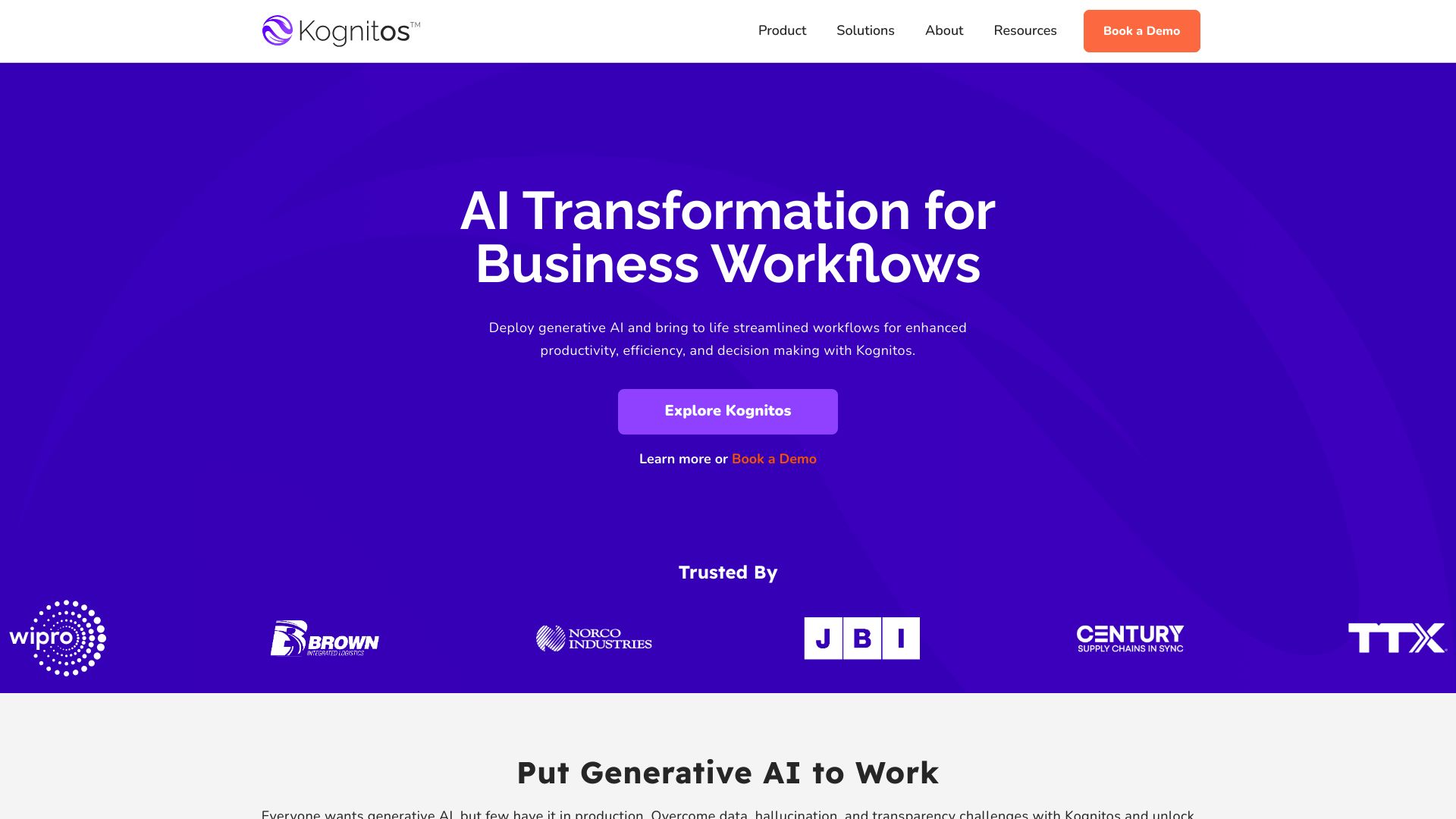Kognitos vs. Magic Loops: AI Automation Showdown
AI-powered automation platforms are reshaping how businesses operate, offering unprecedented efficiency and accessibility. This comparison of Kognitos vs. Magic Loops, and SmythOS unveils the strengths and limitations of each solution. Kognitos revolutionizes automation with its plain English interface, while Magic Loops bridges the gap between no-code tools and full programming environments.
SmythOS, however, emerges as the frontrunner, combining visual programming, multi-agent collaboration, and extensive integrations. Developers will appreciate SmythOS’s API flexibility, business leaders will value its scalability, and non-technical users will find its drag-and-drop interface intuitive. This review equips you with the knowledge to choose the ideal AI automation platform for your specific needs, whether you’re a startup founder, enterprise IT manager, or AI enthusiast.
Kognitos Overview
Kognitos revolutionizes business automation through its innovative AI-powered platform. Users create and manage automation processes using plain English, eliminating the need for complex coding. This approach democratizes AI, making sophisticated automation accessible to a wide range of professionals.
Kognitos revolutionizes business automation through its innovative AI-powered platform. Users create and manage automation processes using plain English, eliminating the need for complex coding.


Kognitos leverages natural language processing and large language models to interpret user instructions and execute tasks autonomously. The platform excels in document processing, data manipulation, and system integration, particularly benefiting industries with complex workflows like finance, healthcare, and logistics.
Kognitos leverages natural language processing … to interpret user instructions and execute tasks autonomously.
Unlike traditional robotic process automation (RPA) tools, Kognitos runs entirely in-browser and utilizes stable API-based automations. This approach eliminates the need for bot management, reducing overhead and simplifying deployment. The system’s ability to learn from user interactions and handle exceptions makes it highly adaptable to changing business needs.
Kognitos integrates seamlessly with third-party applications and supports multiple operating systems, expanding its utility across diverse IT environments. While the platform offers powerful automation capabilities, it may require some learning for users accustomed to visual drag-and-drop interfaces. The focus on natural language interactions, while innovative, might present a slight adjustment period for teams transitioning from traditional automation tools.
Magic Loops Overview
Magic Loops transforms automation by integrating large language models with code to create easily programmable workflows. Users describe tasks in natural language, which Magic Loops converts into runnable “loops” of code and AI blocks. This approach bridges the gap between no-code tools and full programming environments, democratizing automation for a wider audience.
Magic Loops transforms automation by integrating large language models with code to create easily programmable workflows. Users describe tasks in natural language, which Magic Loops converts into runnable “loops” of code and AI blocks.
The platform’s key strengths lie in its flexibility and ease of use. Users can modify loops to meet specific needs, ensuring precise automation tailored to individual requirements. Magic Loops leverages various integrations, APIs, and AI models, making the automation versatile and powerful. The ability to share loops with the community or use existing public loops enhances collaboration and resource sharing.
Magic Loops offers several pre-built templates, such as a YC S23 Watcher that texts users about new YC launches, and a Bland AI Demo that triggers AI phone calls upon receiving emails. These examples showcase the platform’s capability to handle diverse automation tasks across different domains.


While Magic Loops excels in natural language automation, it lacks a visual drag-and-drop interface, which might be a drawback for users who prefer more visual programming methods. The platform focuses on single-agent operations, without explicit support for multi-agent collaborations. This limitation could affect users requiring complex, multi-faceted automations.
Magic Loops integrates well with various APIs for backend automation, similar to robotic process automation functionalities. It supports processing of different file types, including PDFs and Word documents, enhancing its utility for document-heavy workflows. The platform also provides features for handling exceptions and errors, improving the robustness of automations.
The company’s vision to open-source Magic Loops in the future promises greater customization possibilities, potentially allowing users to run it locally and tailor it to specific needs. This commitment to openness aligns with the broader trend of democratizing AI and automation tools, making Magic Loops an intriguing option for developers and businesses seeking flexible, powerful automation solutions.
Feature Comparison
Kognitos and Magic Loops offer distinct approaches to AI-powered automation, with notable differences in their core components and security features. Kognitos excels in natural language processing, allowing users to create automation processes using plain English. This approach eliminates the need for traditional coding, making it accessible to non-technical users. Magic Loops, on the other hand, integrates large language models with code to create programmable workflows, bridging the gap between no-code tools and full programming environments.
In terms of security, both platforms prioritize data protection, but their implementations differ. Kognitos implies robust security measures, including data encryption, as part of its enterprise-grade offerings. Magic Loops, while also security-conscious, does not explicitly mention specific encryption protocols. Both platforms support OAuth for authentication, but Kognitos provides more detailed information about user access management and IP control.
Notably, SmythOS outperforms both in several key areas. It offers a visual drag-and-drop interface, which neither Kognitos nor Magic Loops provide, making it more user-friendly for those who prefer visual programming methods. SmythOS also supports multi-agent collaboration, a feature absent in both Kognitos and Magic Loops, enabling more complex, multi-faceted automations. Additionally, SmythOS provides extensive integration options, including support for Huggingface AI models and Zapier APIs, which are not explicitly mentioned in Kognitos or Magic Loops’ feature sets.
Feature Comparison Table
| Kognitos | Magic Loops | SmythOS | |
|---|---|---|---|
| CORE FEATURES | |||
| Hosted Agents (Dev, Production) | ✅ | ❌ | ✅ |
| Environments (Dev, Production) | ✅ | ❌ | ✅ |
| Visual Builder | ❌ | ❌ | ✅ |
| Autonomous Agents | ✅ | ❌ | ✅ |
| Multimodal | ✅ | ❌ | ✅ |
| Multi-Agent Collaboration | ✅ | ❌ | ✅ |
| Audit Logs for Analytics | ✅ | ❌ | ✅ |
| Work as Team | ✅ | ❌ | ✅ |
| SECURITY | |||
| Constrained Alignment | ❌ | ❌ | ✅ |
| Data Encryption | ✅ | ❌ | ✅ |
| OAuth | ✅ | ❌ | ✅ |
| IP Control | ❌ | ❌ | ✅ |
| COMPONENTS | |||
| Foundation AIs | ✅ | ❌ | ✅ |
| Huggingface AIs | ✅ | ❌ | ✅ |
| Zapier APIs | ❌ | ❌ | ✅ |
| Classifiers | ✅ | ❌ | ✅ |
| Data Lakes | ❌ | ❌ | ✅ |
| DEPLOYMENT OPTIONS (EMBODIMENTS) | |||
| Deploy as Webhook | ❌ | ✅ | ✅ |
| Staging Domains | ✅ | ❌ | ✅ |
| Production Domains | ✅ | ❌ | ✅ |
| Deploy as Site Chat | ❌ | ❌ | ✅ |
| Deploy as GPT | ❌ | ❌ | ✅ |
| DATA LAKE SUPPORT | |||
| Hosted Vector Database | ❌ | ✅ | ✅ |
| Sitemap Crawler | ❌ | ❌ | ✅ |
| YouTube Transcript Crawler | ❌ | ❌ | ✅ |
| URL Crawler | ❌ | ❌ | ✅ |
| PDF Support | ✅ | ❌ | ✅ |
| Word File Support | ✅ | ❌ | ✅ |
| TXT File Support | ✅ | ❌ | ✅ |
Best Alternative to Kognitos and Magic Loops
SmythOS stands out as the superior alternative to Kognitos and Magic Loops for AI-powered automation. Our platform combines powerful features with unparalleled ease of use, making it the ideal choice for businesses seeking to harness the full potential of AI.
We offer a visual drag-and-drop interface that simplifies the creation of complex AI workflows. Unlike Kognitos and Magic Loops, which require some level of coding knowledge, our intuitive design allows users of all skill levels to build sophisticated AI agents quickly and efficiently. This democratization of AI development empowers more team members to contribute to automation projects, accelerating innovation across your organization.
Our intuitive design allows users of all skill levels to build sophisticated AI agents quickly and efficiently. This democratization of AI development empowers more team members to contribute to automation projects…
Our platform’s extensive integration capabilities set it apart from the competition. We support a vast array of AI models from providers like OpenAI, Anthropic, and Hugging Face, as well as seamless connections to popular services such as Slack, Trello, and GitHub. This flexibility ensures that SmythOS can adapt to your existing workflows and tools, maximizing the value of your current technology investments.
Unlike Kognitos and Magic Loops, SmythOS excels in multi-agent collaboration. Our platform enables the creation of teams of AI agents that work together on complex tasks, mimicking human team dynamics. This capability opens up an unlimited range of use cases, from streamlining customer service operations to optimizing supply chain management and beyond.
We prioritize security and scalability, offering features like data encryption, OAuth support, and IP control that meet enterprise-grade standards. Our platform scales effortlessly to handle growing demands, ensuring that your AI solutions remain robust and reliable as your business expands. With SmythOS, you’re not just adopting a tool; you’re investing in a future-proof AI ecosystem that will drive your company’s success for years to come.
Conclusion
Kognitos and Magic Loops offer innovative approaches to AI-powered automation, each with unique strengths. Kognitos excels in natural language processing, allowing users to create automations using plain English. Magic Loops integrates large language models with code for flexible, programmable workflows. Both platforms simplify complex tasks and improve efficiency across various industries.
However, SmythOS emerges as the superior choice, combining the best features of its competitors with additional capabilities. Our platform’s visual drag-and-drop interface makes AI development accessible to users of all skill levels. We support multi-agent collaboration, enabling complex, multi-faceted automations that Kognitos and Magic Loops can’t match. Our extensive integration options, including support for Huggingface AI models and Zapier APIs, provide unparalleled versatility.
SmythOS stands out with its ’Create Once, Deploy Anywhere’ approach, allowing seamless integration across multiple environments. This flexibility, combined with our robust security measures and scalability, makes SmythOS the ideal choice for businesses seeking to harness the full potential of AI automation. Explore our diverse range of AI-powered agent templates to see how SmythOS can transform your workflow. Get started with SmythOS today and experience the future of AI-powered automation.
Last updated:
Disclaimer: The information presented in this article is for general informational purposes only and is provided as is. While we strive to keep the content up-to-date and accurate, we make no representations or warranties of any kind, express or implied, about the completeness, accuracy, reliability, suitability, or availability of the information contained in this article.
Any reliance you place on such information is strictly at your own risk. We reserve the right to make additions, deletions, or modifications to the contents of this article at any time without prior notice.
In no event will we be liable for any loss or damage including without limitation, indirect or consequential loss or damage, or any loss or damage whatsoever arising from loss of data, profits, or any other loss not specified herein arising out of, or in connection with, the use of this article.
Despite our best efforts, this article may contain oversights, errors, or omissions. If you notice any inaccuracies or have concerns about the content, please report them through our content feedback form. Your input helps us maintain the quality and reliability of our information.
